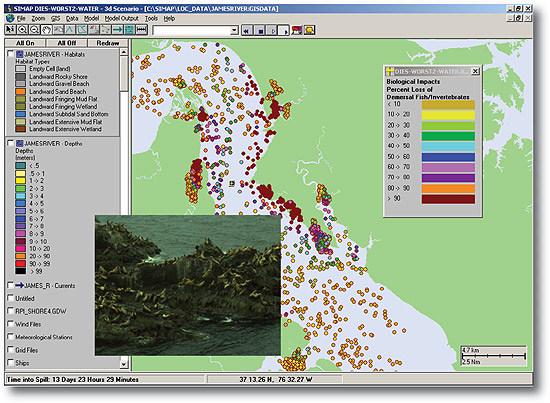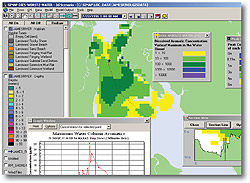Software
SIMAP™
download PDFIntegrated Oil Spill Impact Model System
SIMAP provides detailed predictions of the three-dimensional trajectory, fate, biological effects, and other impacts of spilled oil and fuels.
Applications for SIMAP
- Impact Assessment
- Hindcast/forecast of spill response
- Natural resource damage assessment
- Contingency planning - including worst-case scenario
- Ecological Risk Assessment
- Cost-benefit analysis
- Drills and education
Features
- Contains RPS ASA’s own GIS or can be used in other GIS software such as ArcView®
- Easily interpreted visual displays of surface distribution and subsurface concentrations of spilled oil and its components over time
- Impacts on fish, shellfish, wildlife, and for series of habitats (environments) affected by the spill.
- Location-specifi c environmental/ biological data applied to any fresh or salt aquatic environment in the world
- 3D Viewer capabilities
- Can utilize a variety of hydrodynamic file formats

SIMAP Highlights
- Physical Fates Model
- Biological Exposure and Effects Model
- Stochastic Model
- Interactive GIS
- Environmental, Oil & Biological Databases

Model Modules
Physical Fates Model
-
SIMAP simulates the following processes:
- Initial plume dynamics
- Slick spreading, transport, and entrainment of floating oil
- Evaporation and volatilization (to atmosphere)
- Transport and dispersion of entrained oil and dissolved aromatics in the water column
- Dissolution and adsorption of entrained oil and dissolved aromatics to suspended sediments
- Sedimentation and resuspension
- Natural degradation
- Shoreline entrainment
- Boom and dispersant effectiveness


Biological Exposure and Effects Model
-
The biological exposure model evaluates:
- Area or water volume exposed above a selected threshold(i.e. a toxicological endpoint in US EPA ecological risk assessment terminology)
- Dose (sum of concentration times time of exposure) aquatic biota are exposed to and the expected percent mortality from acute toxic effects
- Direct-contact impacts to birds, mammals, and other wildlife
Stochastic Model
-
The stochastic model predicts:
- Range of expected contamination and the probability of exceeding thresholds of concern from an oil discharge
- Frequency distribution of model results, for which statistics are calculated and plotted
Environmental, Chemical and Biological Databases
- Environmental database - includes coastline, bathymetry, shoreline type, ecological habitat type, and temporally varying ice coverage, temperature, and salinity
- Oil database - includes physical-chemical properties; allows the user to add new oils, duplicate oils already in the database and make changes to oil data while preserving the original values
- Biological databases - can be set up for any area of the world. For the US, RPS ASA has developed a biological database containing seasonal or monthly mean abundance by species and habitat type for each biogeographic region of the US
